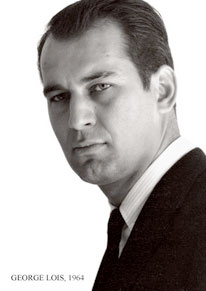Gary Dickson articles:
- Function is Dead -- Long Live Function This is the book review that you won't be reading:
- Nothing Up My Sleeve: Gary reflects on designing logos, dispels some myths and shares anecdotes on what a logo really is.
- Design from the Edge... some noteworthy observations regarding edge-designers, center-designers, their characteristics and their relationship to one another: "Would you rather Design from the Edge?"
- Inspiration in a Bottle: sources of inspiration that may just take you to the next level of creativity! "Where does your inspiration come from?"
A Designers Education
Gary Dickson...
"Creativity can solve almost any problem. The creative act, the defeat of habit by originality, overcomes everything."
-- George Lois
BACK BEFORE THE DAWN OF TIME, back before there existed a "web" let alone any sort of "browser" there was a command line based internet and a handful of services such as CompuServe. Those of us fortunate enough to have access to the internet could navigate only by way of typed commands using telnet, ftp and a few other archaic protocols. I recall one conversation in particular that I engaged in on the usenet. I forget which newsgroup exactly it took place on but it was regarding graphic design education. Someone made a comment that went something like this --
"why would anybody be stupid enough to pay for an education in graphic design or for that matter pay a designer to work on a project, when you could go buy some software and a book and just start designing stuff on your own."
Indeed this attitude still exists for many out there and it's results can be seen all over the place -- not a pretty sight.
I recently had the opportunity to start teaching "digital design tools" at an art college and this usenet conversation has been on my mind a lot since then. Truth be told I had never lent much weight to the importance of mastering any given software program. But, the teaching gig has caused me to reflect on this as well as other aspects of a designers education and I feel compelled to share some of my thoughts with the rest of the world. I would particularly like to speak to those out there who might be considering a career in graphic design. Let me be perfectly clear right up front -- if you think that simply mastering Adobe's Creative Suite or any other software package makes you a designer than you should stop reading this article right now and go find something else to do.
Choose Wisely
There is a distinct and significant difference between the production process and the design process. If you lack a burning passion for design but enjoy using really cool software then please take my advice -- go find a good 2 year trade school and become a production designer. There's nothing wrong with this -- it is simply a different career path and in some respects probably a better choice. You'll save yourself a truckload of money and a lot of headaches. If you obsessively see design -- the good, the bad and the ugly -- in literally everything around you then read on. So, what makes a designer a good designer? What should you look for in a school if you want to be a designer?I believe very strongly that a good design education should be well rounded and should include history, language, science and even some math (you might be surprised by the similarities between designers and mathematicians). Computer hardware and software tools should not be a schools central theme, but they are important -- in fact a good grasp of current tools is fairly crucial. My newly adjusted view on the subject is that a good designer shouldn't have to think about the tools they use. That means really being a master of whatever software you need to use. With this in mind lets reflect a bit on the design process of days gone by. What were the tools of designers like Cassandre, Lowey, Rand, Eames and other historically notable designers? Pencils, brushes, markers, paper, canvas, camera, razor blades, adhesive -- yes, pretty sophisticated stuff. Many other people mastered these difficult tools in days of old but never became accomplished designers.
The Right Stuff 
Chuck Yeager
once said
"If you love the hell out of what, you're doing you're usually good at it, and you wind up making your own breaks."
That's one of my all time favorite quotes and mostly true in my opinion. If you love design you will make it one of the central elements of your life -- loving technology is not the same as loving design. Loving design means learning it's history, culture and the philosophical guidelines of successful designers. This also means following their examples in an attempt to learn and understand what drove them and guided them. Most of them you will find were educated in design (or art) and were inspired by a basic knowledge of history, language, science, architecture, design and art of all kinds.
I think it is important here to note that as a designer it is extremely important to form your own design opinions. Any aspiring designer should learn all the basic design "rules". Beyond that you can and should study other peoples design ideas. You can do that forever and will eventually become a very competent designer doing so. But a dedicated designer must eventually develop their own set of guides.
There is an Awful Trend Today in Design. 
It is the use of focus groups to determine what makes good design. Polling a group of people, even a group of designers, creates at best lukewarm design. Read your history and you will find that many of the best designers have been deeply opinionated, stubborn, difficult and would never have settled to take a vote on any element of one of their designs. With regard to the use of focus groups and similar tactics, George Lois
once said,
"You can't research a big idea. The only ideas that truly research well are mediocre ideas. In research, great ideas are always suspect."
For those who seek to become designers, the bottom-line is this -- first fall in love with everything about design (particularly the design process). Then find a school where you feel comfortable, where the computer lab is important but not glorified, where history, language, science and math play a significant role.
Mostly, however, find a school where design gestalt and concept are the core.
Delightfully Never-Ending
 If you are already consider yourself a designer, your education should never be over. This is one of the things that I love most about design. Every new client and every new project should be an opportunity to learn or discover something new. Even when there may be only a few "billable" hours in a day there should always be something going on in your mind that pertains to design. Designers design things -- always! You should take every opportunity to view the world with a designers eye regardless of the time of day or where you may be. I ran across a very cool book this week called "100 Habits of Successful Graphic Designers", by Josh Berger
If you are already consider yourself a designer, your education should never be over. This is one of the things that I love most about design. Every new client and every new project should be an opportunity to learn or discover something new. Even when there may be only a few "billable" hours in a day there should always be something going on in your mind that pertains to design. Designers design things -- always! You should take every opportunity to view the world with a designers eye regardless of the time of day or where you may be. I ran across a very cool book this week called "100 Habits of Successful Graphic Designers", by Josh Berger
Being a Designer is a Wonderful Thing
I can think of no other life I would rather lead -- "designer" is just as much a definition of who I am as what I do. I believe that clients pay me to have an opinion but also to be open to new influences and anxious to learn about their business. My education began when I made the decision to become a designer, it clearly has been retroactive and frankly I hope that it never ends.
Gary Dickson
See other Dickson articles:
- Function is Dead -- Long Live Function This is the book review that you won't be reading:
- Nothing Up My Sleeve: Gary reflects on designing logos, dispels some myths and shares anecdotes on what a logo really is.
- Design from the Edge... some noteworthy observations regarding edge-designers, center-designers, their characteristics and their relationship to one another: "Would you rather Design from the Edge?"
- Inspiration in a Bottle: sources of inspiration that may just take you to the next level of creativity! "Where does your inspiration come from?"
Permission to publish this article electronically or in print must be obtained from author prior to publication Ð bylines must be included with publication. Please contact Gary Dickson
Return to the Design Department, or back to the Front Page
Participate in your Design Center
Lots of fun and information for all... don't forget, any community is only as good as the participation of its members. We invite your tips, tricks, comments, suggestions and camaraderie.- Ask for the DT&G Monthly: to receive news about DT& headlines, happenings in the Design Center and regular columns like the "Mail Bag" and "Cool Sites"
- SUBSCRIBE : to the Designers' CAFE email list



